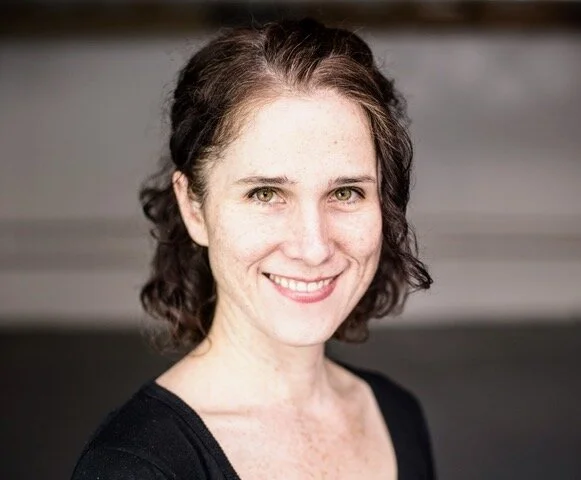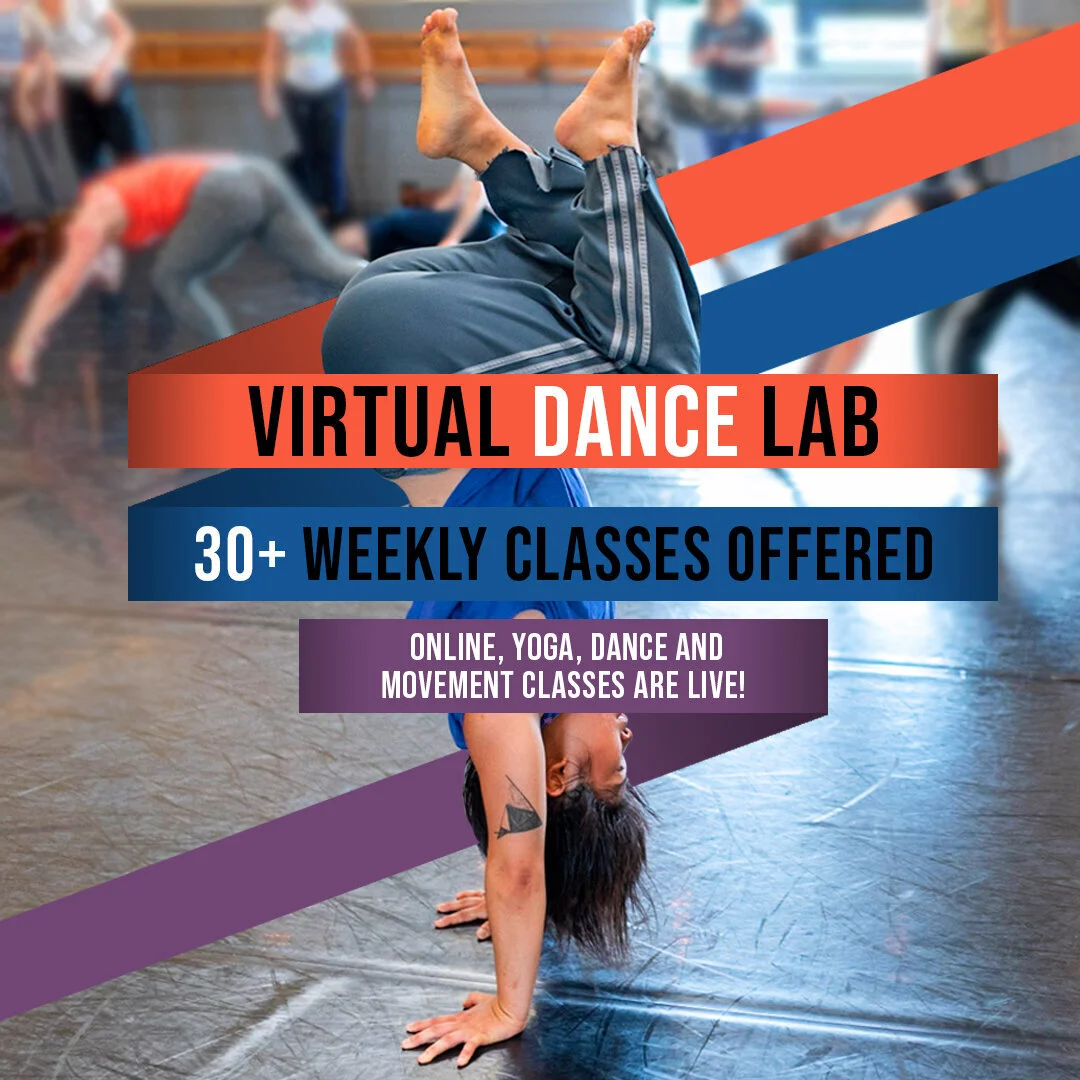Virtual Dance Lab Brings Dance to Your Living Room
This past Spring, when COVID-19 radically shifted the way we move—and yes, dance—through the world, TAPS Lecturer Julia Rhoads was not about to sit still. Through a collaboration with her own dance company, Lucky Plush Productions, and UChicago's Dance Program in TAPS, Virtual Dance Lab was born. During the initial onset of the crisis, Virtual Dance Lab brought free or low cost dance and movement workshops not just to the UChicago students in the TAPS Dance Program, but to the staff, faculty, and greater community, all of whom were adjusting to a life moved abruptly indoors.
This Fall, Virtual Dance Lab has returned, with greatly expanded class offerings. UChicago Arts spoke with Julia Rhoads about the genesis of VDL, how it's grown, and her own dance practice during COVID-19.
Could you tell me a little bit more about the collaboration between Lucky Plush and UChicago, pre-pandemic?
I started up the TAPS Dance Program two years ago, and it’s been exciting to watch it grow so quickly. TAPS has introduced several dance courses with a hybrid studio/seminar format, including an Arts Core, and students can major or minor in TAPS with a dance focus. We have also expanded co-curricular offerings with ongoing technique classes and workshops in a wide range of dance forms, movement practices, and physical theater. A big reason I was able to grow the TAPS Dance Program so quickly was to leverage the support of my dance-theater company, Lucky Plush Productions, which has served as a resident company in TAPS. By working with our artists who are trained in a wide range of dance and interdisciplinary practices—as well as drawing upon Lucky Plush's extended network of teaching artists and collaborators in the field—I have been able to connect individual students and RSO's with some of Chicago’s leading dance artists.
Lucky Plush members have also created choreography for student performances, advised dance RSO productions, and taught several master classes and workshops. The company’s leadership has also engaged student interns and fellows through its arts management sustainability initiatives and have helped connect the TAPS Dance Program’s activities with the broader community.
What was the original impetus for the Virtual Dance Lab? What was it like going through the creation process of the VDL?
The Dance Program’s partnership with Lucky Plush was particularly important when the pandemic shut down everything during spring quarter. The company's artistic and administrative staff was able to respond quickly by creating Virtual Dance Lab, an online home for dance practice and embodied research.
With the support of TAPS, Lucky Plush offered 25+ classes/week through VDL during spring quarter. In addition to serving UC’s students, faculty, and staff, the platform reached local dance artists through Lucky Plush’s network and an exciting new global community of people who wanted to keep their bodies moving while sheltering in place. VDL had over 3,300 class registrations during spring quarter with people logging in from 22 countries. We also partnered with UChicago’s student-led Dance Council to offer specialty workshops with national instructors.
Was there anything that surprised you about the VDL in terms of response – for example, who was participating in the workshops, how teachers of workshops and or the students felt engaging in them, etc?
The biggest thing that surprised me was how many people the platform attracted who have no prior experience in dance. I think there’s a feeling of safety in trying new things from the comfort of your own home and having the option to turn your camera on or off. And with the closing of gyms and other go-to places for exercise, VDL has drawn a whole new population to dance and movement practices.
This fall quarter is the second iteration of the Virtual Dance Lab. What has changed since your first iteration? What was the motivation to continue it?
We’ve started recording classes so that people with scheduling conflicts can access classes anytime. We also continue to expand our teaching roster by engaging Logan’s community partners and organizations from across the city, allowing us to offer a wide range of forms like contemporary, hip-hop, ballet, jazz, West African, and Cuban Salsa. We’re also offering regular yoga classes and workshops in Laban Movement Analysis. It’s a really great and diverse set of offerings!
In reading about Lucky Plush on your website, this line from the "about" section stood out to me: "The company is committed to provoking and supporting an immediacy of presence—a palpable live-ness—shared by performers in real time with audiences." In a global pandemic in which social distancing is the norm and live performance is on hold, have you been able to cultivate this immediacy in the digital space?
The liveness and immediacy of presence that is at the heart of Lucky Plush’s work is most profoundly shared when people are gathered in real-time, real-space. It’s an energy that is felt when performers can sense each other’s weight, breath, and the nuances of interpersonal communication, and when audiences are leaning forward and ready to respond. That said, there have been unexpected benefits to virtual programming, especially in VDL classes. People focus more on their internal experience of movement when they aren’t surrounded by the mirrors in a dance studio. There's also a different kind of immediacy that is generated by seeing a group of people dancing with you online, from their living rooms that are located all across the globe.
As a dancer and artist yourself, how did you cope with the onset of the pandemic in your own practice as an artist? And how are you coping now?
Mostly I’ve tried to find new ways of supporting my artists. Lucky Plush’s ensemble is at the heart of our work because they bring their personal stories and diverse movement backgrounds to our collaborative devising process. We aren’t back in the rehearsal room because we partner, share weight, and layer choreography with nuanced dialogue. None of this works with social distance and masks. But I’ve been able to keep our artists employed through VDL and other online programming, which has been great. We’ve also raised funds to support anti-racism work in the arts, donating a week of VDL proceeds to Enrich Chicago—an arts-led movement to undo racism—as well as participating in a cohort through their programming. These are a couple ways I’ve coped with the pandemic while continuing to deepen my practice and engage meaningfully with my field.
Register for classes at the Virtual Dance Lab here.
Julia Rhoads is the founding Artistic Director of Chicago-based Lucky Plush Productions, a dance-theater company that creates original productions with a signature blend of technical choreography, casual dialogue, surprising humor, and socially relevant themes. Her work for Lucky Plush has been presented in over 55 US and international cities, and commissioning partners include Harris Theater (IL), Clarice Smith Center (MD), Museum of Contemporary Art Chicago (IL), Flynn Center for the Performing Arts (VT), Krannert Center at University of Illinois, The Yard (MA), and Links Hall (IL). Independent choreography credits include Hubbard Street Dance Chicago, Steppenwolf Theatre, Lookingglass Theatre, Walkabout Theater, Redmoon, and River North Chicago Dance Company, among others. Under her leadership, Lucky Plush received the prestigious MacArthur Award in 2016, and creation and touring awards include National Endowment for the Arts, National Dance Project, National Theater Project, and National Performance Network. She is the recipient of an Alpert Award in Dance, fellowships from Maggie Allesee National Center for Choreography, Illinois Arts Council, Chicago Dancemakers Forum and the Jacob K Javits Foundation, and her innovative arts management practices were recognized with a Fractured Atlas Arts Entrepreneurship Award. She is a former member of the San Francisco Ballet and ensemble member of XSIGHT! Performance Group, and received her BA in History from Northwestern University and her MFA in Performance from the School of the Art Institute Chicago.




